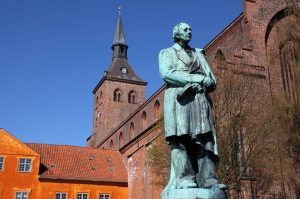Our final poetry news round up of 2021 looks at the magical new museum dedicated to the life and work of the poet and writer Hans Christian Andersen.
Museum Dedicated to Hans Christian Andersen Revamped
 The poet and writer Hans Christian Andersen died at the age of 70, 146 years ago. His work is still remembered, and his life is celebrated all over the world. The most recent of these celebrations can be found in his hometown in Denmark, where they have recently completed work on a museum that is dedicated not only to his life but also immersing visitors in the fairy-tale, fantasy world that he created.
The poet and writer Hans Christian Andersen died at the age of 70, 146 years ago. His work is still remembered, and his life is celebrated all over the world. The most recent of these celebrations can be found in his hometown in Denmark, where they have recently completed work on a museum that is dedicated not only to his life but also immersing visitors in the fairy-tale, fantasy world that he created.
The new museum was opened in the summer and the renovation work was completed at the beginning of this month, shortly before the building was forced to close once again as part of the Danish measures against the new strain of Covid-19. In the short time that it was open however, the many visitors who went through its door expressed their delight at what they found.
This new museum is a replacement for the Hans Christian Andersen Museum that was located in the central Denmark town of Odense. This was a traditional “biographical museum” that was filled full of text and artefacts, what it didn’t have, and what visitors were looking for were the fairy tales that he had written, and this is exactly what the new museum offers.
The renovations have taken seven years and the museum is now a sprawling complex that can be seen not only above the cobbled streets of the city but also below them as well. The entrance to the museum takes visitors through the cottage where the writer spent his early childhood. From here they are transported into a series of spaces that are devoted to his many stories, with interactive exhibits, animations and music.
During his lifetime Andersen wrote a staggering 800 poems and 158 fairy tales. He enjoyed success in later life thanks to works like “Thumbelina” and “The Emperor’s New Clothes”.
Visitors to the museum can see artefacts such as the original inkwell that Andersen used, and the Champagne glass that was given to him by the Swedish singer, Jenny Lind when she turned down his proposal of marriage.
The design for the museum is the work of Kengo Kuma the Japanese architect who was also responsible for the new Olympic stadium in Tokyo. The below ground element of the design, which sees two thirds of the building hidden from view was inspired by “The Tinderbox” a story by Andersen which sees a hollow tree being used as a gateway to a world underground – Kuma took much of his inspiration for the design from a number of elements that can be found in Andersen’s work.
The original plans for the museum were submitted to the city in 2010 and the work began in 2014 following the necessary closure of a major road that travelled over the space that was to be used. In 2017 the old museum closed its doors for the last time.
In the short time since the museum has been reopened it has had 40,000 visitors, the majority of whom were domestic visitors rather than foreign tourists. The old museum was usually visited by around 100,000 people per year, a significant number of whom came from abroad with around 20,000 coming from China.


You must register to comment. Log in or Register.